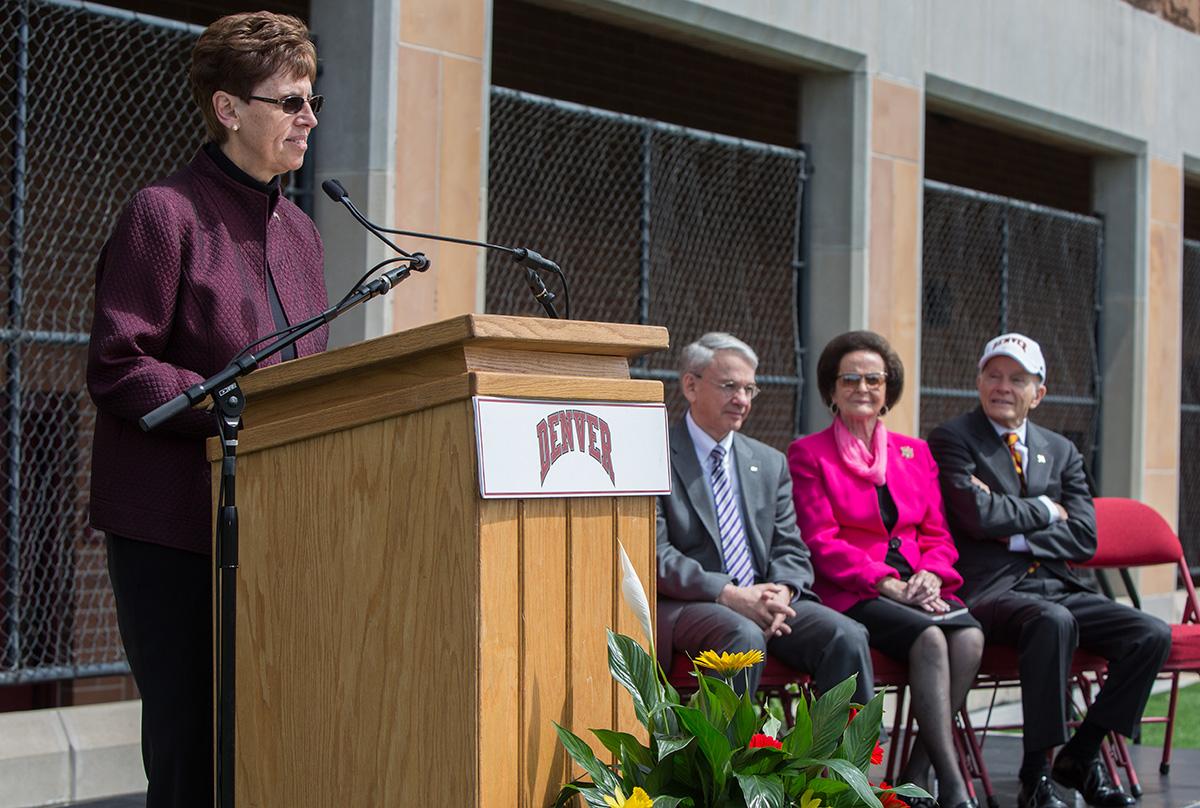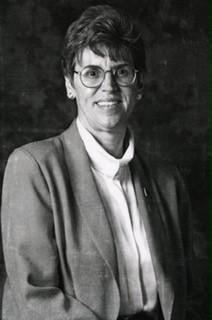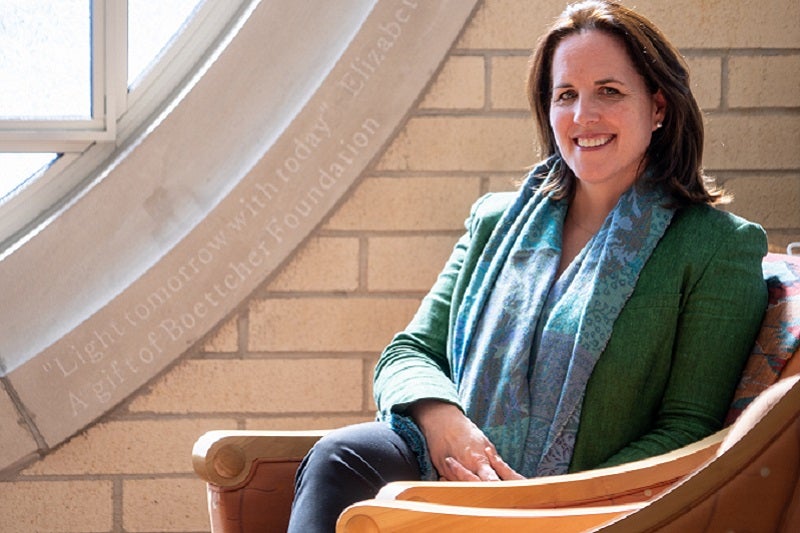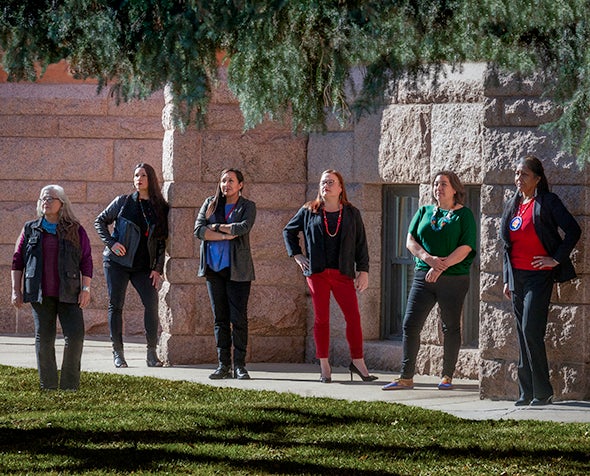Celebrating Women's History Month With Diane Wendt

Diane Wendt at the Dedication of DU's Diane Wendt Sports Field
“No person in the United States shall, on the basis of sex, be excluded from participation in, be denied the benefits of, or be subject to discrimination under any educational program or activity receiving federal financial assistance.”
For Diane Wendt, these 37 words from Title IX of the Educational Amendments to the 1964 Civil Rights Act pack a powerful punch. They represent the values she pursued throughout her career and during her time as DU’s first director of women’s athletics and later as senior associate athletics director. In addition to her work on campus, she also lent expertise and passion to the successful implementation of Title IX nationally.
In celebration of Women’s History Month and International Women’s Day, Wendt spoke with the DU Newsroom via email about the evolution of equality in sports and the work still ahead of us. The conversation has been condensed and edited for clarity.
Tell us about what your role as director of women’s athletics in 1974.
I was initially hired at DU in 1971 as an instructor of physical education and health education and was assigned to coordinate women’s intramural and club sport programs administered under the Department of Physical Education. Intercollegiate athletics programs for men were administered under the athletics department, where funding, benefits and opportunities were significantly greater than those provided for women.
When Title IX was enacted in 1972, colleges and universities were required by law to take steps to ensure their athletics programs came into compliance with specific regulations that were published and distributed. I was in a unique position to understand the landscape of women’s sports and became an advocate for advancing equal educational opportunity in intercollegiate athletics at the University of Denver.
Achieving parity in DU men’s and women’s sports programs was dependent on having both programs administered under the same department, the Department of Athletics. The University central administration endorsed this concept, and in 1974, I was appointed director of women’s athletics and transferred to work in the Department of Athletics. My role was to provide the leadership and oversight necessary for the start and ongoing administration of the women’s intercollegiate athletics program.
At this same time, the University launched five intercollegiate athletics programs for women in the sports of basketball, field hockey, gymnastics, skiing and tennis. A total budget of $15,000 was appropriated by the University budget office to support all five sports.
You also were appointed as a consultant to a team of Title IX officials in the Office of Civil Rights, which was tasked with providing clarification for Title IX regulations in college athletics. How did you come to be on that committee and what were some of the challenges?
When Title IX regulations for intercollegiate athletics were initially released, there was a great deal of controversy and lack of understanding as to how the regulations should be applied. Additional clarification was needed, [so] the Department of Health, Education and Welfare appointed a team of officials from the Office of Civil Rights (OCR) to address this need.
I had co-authored and co-directed a Women’s Educational Equity Program Grant in 1978 to launch the Colorado Girls’ and Women’s Sports Commission, a clearinghouse of information and resources to promote and support girls’ and women’s sports participation throughout the state of Colorado. My work with this program, combined with [my work at] DU, was most likely the reason I was considered and selected to be a Title IX consultant.
The team’s assignment was to review existing regulations, propose written clarifications and recommend steps that would help schools move programs toward Title IX compliance. The biggest challenges associated with this mission were dealing with the outcries of resistance from representatives of schools and conferences with football programs, who declared that football should be exempted from the regulations. There were also objections from administrators and coaches at other schools claiming that Title IX would be the death of men’s athletics.
In spite of ongoing protests and resistance, an official document providing written clarification of the Title IX regulations was approved and released by the OCR in 1979 in hopes of assisting colleges and universities [in their] move toward compliance.
What prompted the formation of DU’s Gender Equity Task Force, and what task force accomplishments are you most proud of?
In 1992, I was appointed to serve on the NCAA Gender Equity Task Force commissioned to survey the status of progress with Title IX implementation at NCAA member schools throughout the country. This task force was also charged with generating recommendations that would help schools move toward compliance.
Participating in this process was the most contentious experience I have ever been part of in my entire professional career. Representatives from football power schools were intent on exempting football from the Title IX regulations throughout the process; however, they were not successful. The regulations remained as written, and all sports were required to comply with the regulations as defined.
As contentious as this experience was, I learned the value of the process and recommended the formation of a similar committee structure at the University of Denver. A DU Gender Equity Task Force was appointed in 1993 with representation from coaches of men’s and women’s sports, athletic administrators, administrators from central administration, faculty, staff and invited consultants.
Thanks to the leadership and contributions of many, gender equity was achieved, and our men and women student-athletes are the beneficiaries.
What was the state of athletics before Title IX?
Before Title IX … women were able to enjoy sports participation opportunities, but their participation was significantly underfunded and certainly not at the same competitive level as those for men.
While male student-athletes enjoyed the benefits of athletics scholarships, full-time coaching, training table, academic support, locker rooms, subsidized travel, weight rooms, uniforms, athletics training, media coverage, publicity and equipment support, women participated in intramural and club sports with significantly limited staff and financial support.
From your perspective, what are some of the most significant changes that have come out of Title IX?
Title IX was responsible for a sea change in education at all levels, which ensured male and female students would have access to equitable educational programs. Title IX also provided a wide range of protections — from athletics and admission to housing and sexual harassment.
As a result, girls and women, as well as boys and men, gained access to and were able to enjoy the benefits of educational programs previously dominated by a single gender. I believe the legacy of these expanded educational opportunities was greater and more impactful than anyone could have imagined when the law was initially passed. A few highlights of the Title IX legacy are:
NCAA Division I and II schools are providing more than $2.9 billion in athletics scholarships annually to more than 150,000 student-athletes. Approximately 43–44% of that amount is now awarded to women student-athletes.
According to the NCAA News, NCAA women student-athletes participating in intercollegiate athletics in 2017–18 represented 44% of the total number of participating NCAA student-athletes.
Although there has been much progress toward achieving gender equity in college athletics to date, it is important for school administrators to remain vigilant, to monitor and adjust budgets annually as may be necessary and, when administrative decisions are being considered relative to program policy, planning and budgeting, to continue to ask, “Is this equitable?”
Title IX certainly hasn’t solved all issues for women’s athletics. What should we focus on now?
Diversity and inclusion continue to be top priorities in the hiring of coaches and athletics administrators. According to the 2018 Race and Gender Report Card, 33.7% of participating Division I student-athletes are people of color, yet only 15.1% of Division I head coaches of women’s teams are people of color. More efforts are needed and required to recruit and retain people of color in college coaching and administrative positions.
Recruitment of more women in coaching and administrative leadership positions continues to be a challenge and special need, as well.
What has fueled your long and determined fight for women in athletics?
I was very active and athletic growing up in the ’50s and always thought of myself as being an undiscovered Olympic athlete. In reality, nothing could have been further from the truth, but I yearned for opportunities to participate in organized sports. There were no such opportunities available for girls where and when I grew up. The best opportunity for me was to participate in the Girls Athletic Association at my high school and enjoy periodic “play days” where we were organized into groups of girls lined up to participate in relays.
Given my background and experiences growing up, my appointment at the University of Denver, and the passage of Title IX in 1972, I was at the right place at the right time to work at making a difference for girls and women interested in sports participation. I was fueled by each and all of these circumstances together.
Most rewarding of all, I am in awe of the legacy of Title IX. When I attend DU athletics events now, [I] see how bright, articulate, poised and accomplished our men and women student-athletes are when they represent the University and compete.











